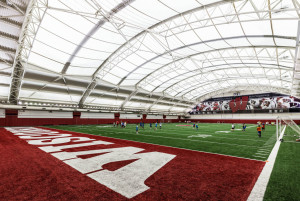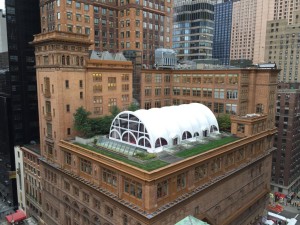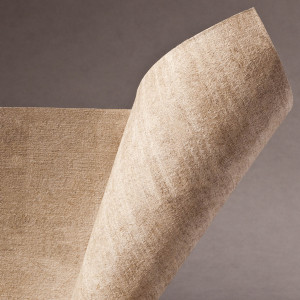
New materials for architectural applications include impressive advanced flexible composites.
Buildings are supposed to stand up strong and—believe it or not—be both flexible and durable. Despite impressions to the contrary, even buildings made of steel and concrete must be flexible to resist cracking and ultimately falling apart. The length to which architects and building experts go to provide expansion joints and other small, nearly invisible points of flexible stress (for all materials used) in a building is the height of successful construction … and of lessons learned over hundreds of years of failures.
With fabric structures, the same holds true for every flex joint and attachment point, as well as the fabric itself. Perhaps the area of material development with the greatest growth potential in fabric structures is with flexible composites. Generally, composites are considered to be rigid forms that began as flexible fabric or mesh scrims that are made stiff by the addition of a binding agent called the matrix.
Many common building materials from prehistoric times on, such as bricks made from mud mixed with straw and baked hard, could be considered composites in the strict sense. Animal skins tied to wooden frames (like tepees, the original fabric structures) are another example. Essentially, by combining two different materials, a third, high-performance material is created with unique performance advantages. This can be summed up by the simple equation: 1 + 1 = 3. In other words, the combined materials have characteristics that are more than the sum of their parts.
Flexible, translucent and warm

Unlike most composites, flexible composites remain flexible after the manufacturing process, and are gaining use in many architectural applications. Key to this acceptance is the introduction of higher performance characteristics that architects and their clients require: higher thermal resistance (or R-value) and improved sustainability, both in the manufacture and in performance of the material after installation. One early market innovation was Birdair Inc.’s Tensotherm™, introduced in 2006 and increasingly in demand. The product—developed jointly by Birdair, Cabot Corp. and Geiger Engineering—sandwiches layers of translucent PTFE-glass fiber fabric with a core of Lumira™ aerogel by Cabot that is designed to transmit light while increasing insulation values.
“Tensotherm is in constant evolution,” says Tom Connell, Birdair’s business development manager. “We regularly review how the composite materials go together to obtain the desired results. The focus is on specific combinations of materials to meet the needs of the project where it is used.” A case in point is the recently completed McClain Center at the University of Wisconsin, located in Madison, Wis. The roof of the indoor practice field house was originally constructed by Birdair in 1981 with a non-insulated PTFE-glass fabric. As part of a major “Athletic Village” development, the university set aside a sum of money to retrofit the facility roof to increase its performance and R-value while maintaining its earlier appearance. The new 42,000-square feet Tensotherm roof consists of a 25mm core of aerogel between structural layers of PTFE fabric for a total of 40mm thickness (less than two inches) to produce an insulation value of R9, reducing solar heat gain in warm seasons, and retaining heat in Wisconsin’s cold winters.
Working with light

Another area of innovation involves the integration of photovoltaics with structural fabrics. Brooklyn, N.Y.-based Pvilion is focused on research, prototyping and bringing to market all manner of flexible PV products. The research, conducted over the past 15 years, includes partnering earlier this year with the Rhode Island School of Design (RISD) architecture department, Brown University’s engineering school and the University of Erfurt, for the 2014 Solar Decathlon entry called “Techstyle Haus” (see Fabric solar house competes at Versailles).
Every other year, the international design competition, Solar Decathlon, challenges architecture students to design and build prototype houses that meet stringent energy efficiency and sustainability standards with the goal of innovation and education of future designers. Pvilion’s technical advice and materials contribution to the collaboration “allowed the construction of an entirely fabric-based solar-powered house, helping the lightweight structure to keep weight down and design flexibility high,” says Colin Touhey, co-founder and CEO of Pvilion. “The potential for integrated flexible PV will only grow, as we see it, as efficiencies of production and voltage output increase and size of installations gets bigger to encase whole façades of buildings.”
Pvilion has also explored the small scale markets, recently working with fashion designer Tommy Hilfiger to produce a line of solar panel jackets powered by flexible PV with a built-in battery that can store enough energy for three smartphones or charge a tablet or smartphone in a few hours. Other company research has led to Pvilion’s Airtent, which debuted in early October 2014 (and uses this unique composite material) for Carnegie Hall’s Opening Night Gala. Pvilion, as general contractor and design engineers, led a team composed of Anchor Industries Inc. and Stamford Tent and Event Services Inc. to create a high-pressure airbeam structure for deployment on the new Carnegie Hall Roof Terrace.
The composite airbeams, made of woven polyester materials by Federal Fabrics-Fibers Inc., Lowell, Mass., and the fabric top, fabricated by Anchor Industries from Ferrari 502 fabric, are engineered to meet New York City’s building code. The unit can fit into Carnegie Hall’s freight elevator and substantially reduces the cost of installation by reducing labor and eliminating the need for a crane. At 53-feet by 92-feet by 28-feet high, the structure seats 365 people for dinner, and more for other event types.
Surface attractions

Another area of innovation is in the coatings of composites. Manufacturers of these products tend to take existing product lines and make improvements that enhance sustainability or performance, or both. Serge Ferrari recently introduced its Précontraint® TX30 technical fabric, designed for use in “major construction projects, tensile roofs and structures and for large, free-span and anticlastic shapes.” The innovation is in the “crosslink” PVDF top surface coating that adds links between molecular chains to provide high resistance to photo oxidation and micro-cracks, and prevents dirt in-graining. The new formula allows for a durable, 30-year life span building material that meets Type-II to Type-V classification.
More than any single thing in the past 100 years, the biggest driver in building design and materials innovation is sustainability technology, which has forced major changes in how structures are built. This is especially true for new building materials, and, just as with the transportation industries, building material manufacturers are finding substitutes for petroleum-based sourcing. The German company Norafin Industries, a manufacturer of specialty and technical nonwovens, has introduced a line of flax fiber products based on its hydroentangling process. Norafin advocates the use of the natural fiber for a number of reasons, including the material’s biodegradability, recyclability, great tensile strength and low elongation properties.
According to Norafin, flax composites can also be efficiently produced (going directly from fiber to the mill web) using a spunlacing method, and it compares favorably against other natural fibers on a cost-per-kilogram basis. Norafin has found applications in the building sector with its flax products used for window shades (interior use) and roofing membranes, due to the product’s high UV resistance. The company has identified other areas where the flax-based composite finds natural markets, including packaging, filtration and sports equipment.
Ongoing research
As increased demand for improved performance continues to press upon the building trades, research and testing continue to respond with new products using flexible composites. At IFAI Expo in October 2014, Textile Testing & Innovation LLC, Longmont, Colo., revealed its research on a flexible composite technology that combines flexible tubes within a thermal storage medium that is laminated with flexible PV modules.
Electricity is generated from the PV modules and the thermal storage medium absorbs and stores excess heat from the PV modules, enhancing their efficiency by up to 50 percent. In addition, water is pumped through the embedded tubing to capture heat stored in the medium to produce hot water. Textile Testing’s president, Dr. Barbara Pause, sees the application of this technology as ideal for tensile fabric structures such as shelters for disaster response and crisis management.
Also at IFAI Expo, Dr. Julianna Abel, assistant professor in mechanical engineering at the University of Minnesota, with a specialty in smart materials, described her ongoing research in smart materials using knitted flexible actuators to create unique forms that one day could help shape buildings.
Other research continues at several research universities, including Philadelphia University MAG Composites Institute, where the use of waste materials (such as hemp, flax and chicken feathers, by-products of industrial processing) is being explored to produce new sustainable composites for architectural use. Philadelphia University says reports on at least two funded research projects in this area are expected next year.
All of these materials and ongoing research have the potential to make a significant impact on the building industry’s use of sustainable, flexible composites. Given the scope of their technical capabilities and advantages in sustainability, combined with new methods of manufacturing, future applications for these materials in architecture and building will continue to expand.
 TEXTILES.ORG
TEXTILES.ORG


